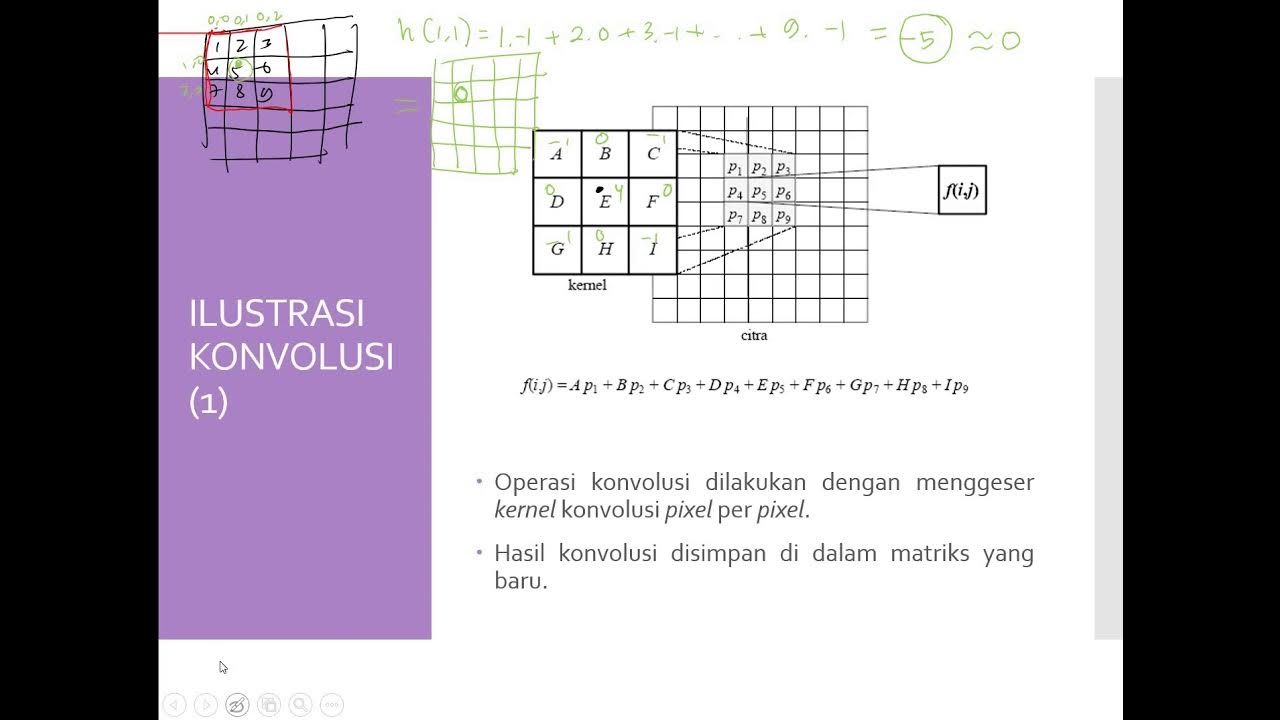How mean filter in Image Processing works ? | Computer Vision | OpenCV | Image Smothing blur
Summary
TLDRIn this tutorial, we explore image smoothing techniques, focusing on the mean filter for noise reduction. The mean filter averages pixel values in a defined kernel (e.g., 3x3) as it moves over the image, reducing the image size in the process. We discuss maintaining image dimensions using zero-padding or pixel replication. While the mean filter is effective for basic noise removal, it has limitations: noise sensitivity can affect neighboring pixels, and sharpness is often reduced with larger kernels. A demonstration shows the trade-off between noise reduction and sharpness, with the kernel size influencing the final image quality. For better results, exploring alternative filters might be necessary.
Takeaways
- 😀 The **mean filter** is a simple and intuitive technique used for **image smoothing** to reduce noise.
- 😀 The mean filter works by averaging pixel values in the image using a kernel (e.g., 3x3) applied to each part of the image.
- 😀 **Convolution** of the kernel with the image involves summing pixel values after multiplying them by the kernel and dividing the sum by the number of elements.
- 😀 The **image size decreases** after applying the filter, with the new dimensions determined by the formula: (height - kernel height + 1) x (width - kernel width + 1).
- 😀 To keep the image size unchanged, techniques like **zero padding** (adding zeros around the image) or **replicating edge pixels** are used.
- 😀 The **corner pixels** have fewer neighboring pixels to average, while edge pixels average more values, potentially affecting the result.
- 😀 **Zero padding** or **replication** techniques can increase the image size (e.g., from 6x6 to 8x8) to help maintain dimensionality after filtering.
- 😀 One key drawback of the **mean filter** is that it can lead to **blurring** of edges, as it smoothens the image.
- 😀 Another drawback is that **noisy pixels** may affect neighboring pixel values, leading to visible **'zombie' patches** or unwanted colors in the image.
- 😀 Increasing the kernel size reduces noise, but it also causes more **blurring**, creating a trade-off between noise reduction and sharpness.
Q & A
What is the main purpose of the mean filter in image processing?
-The mean filter is primarily used to reduce noise in an image by averaging the values of neighboring pixels.
How does the mean filter work on a 6x6 image using a 3x3 kernel?
-The mean filter is applied by placing a 3x3 kernel on the top-left corner of the image, multiplying each pixel's value by the corresponding kernel value, summing them, and then dividing by 9 (the total number of elements in the kernel). The pixel value is then updated with this average, and the process is repeated across the image.
What happens to the dimensions of the image after applying a 3x3 kernel?
-The image dimensions are reduced. For a 6x6 image and a 3x3 kernel, the new image size will be 4x4, calculated by the formula: (Height - Kernel Height + 1) x (Width - Kernel Width + 1).
What methods can be used to maintain the original image size when applying a filter?
-Methods like zero-padding (adding zeros around the image) or replicating edge pixels can be used to keep the image size the same while applying a filter.
What is zero-padding in the context of image filtering?
-Zero-padding involves adding rows and columns of zeros around the image to preserve the image dimensions when applying a kernel filter.
How does the mean filter cause the loss of sharpness in an image?
-The mean filter causes a loss of sharpness because it averages neighboring pixels, which can blur the edges of objects in the image, making them less distinct.
What is the trade-off when using larger kernels for noise reduction?
-Larger kernels reduce noise more effectively, but they also increase the blurring of the image, leading to a loss of sharpness and detail.
What issue can arise from using a mean filter on a noisy image?
-Using a mean filter on a noisy image can lead to 'zombie patches' of non-uniform color, where the filter inadvertently introduces color inconsistencies due to the averaging process.
What is the impact of increasing the kernel size on image noise and sharpness?
-Increasing the kernel size reduces noise but causes more blurring, making the image less sharp as the kernel averages a larger set of neighboring pixels.
How does the video demonstrate the effect of different kernel sizes on an image?
-The video demonstrates the effect of increasing kernel size by progressively using larger kernels (e.g., 9x9, 11x11, 13x13) and showing how noise is reduced but sharpness is lost as the kernel size grows.
Outlines

Этот раздел доступен только подписчикам платных тарифов. Пожалуйста, перейдите на платный тариф для доступа.
Перейти на платный тарифMindmap

Этот раздел доступен только подписчикам платных тарифов. Пожалуйста, перейдите на платный тариф для доступа.
Перейти на платный тарифKeywords

Этот раздел доступен только подписчикам платных тарифов. Пожалуйста, перейдите на платный тариф для доступа.
Перейти на платный тарифHighlights

Этот раздел доступен только подписчикам платных тарифов. Пожалуйста, перейдите на платный тариф для доступа.
Перейти на платный тарифTranscripts

Этот раздел доступен только подписчикам платных тарифов. Пожалуйста, перейдите на платный тариф для доступа.
Перейти на платный тарифПосмотреть больше похожих видео

Filtering

FPGA Accelerated Stewart Platform Stabilization Using Xilinx Zynq - OpenHW'24 Submission AOHW-239

#21 OPENCV - PYTHON | Canny Edge Detection EXPLAINED | Coding SOBEL, LAPLACIAN and CANNY Filters

Konvolusi Citra Digital

Nlp - 2.8 - Kneser-Ney Smoothing

Konvolusi Pengolahan Citra Digital | Secara Garis Besar #1
5.0 / 5 (0 votes)
